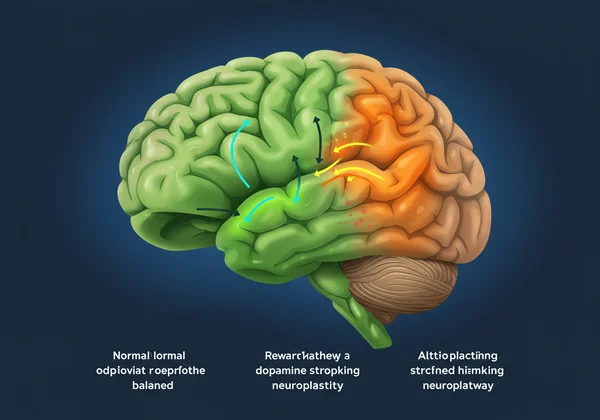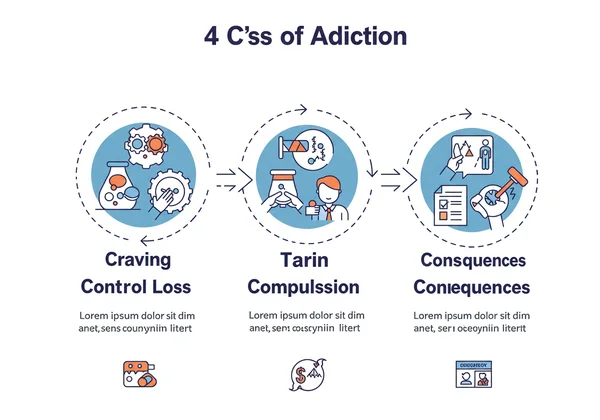成瘾测试:了解成瘾的 4 C 原则以及如何判断自己是否成瘾
我们很多人都想知道,一个坏习惯何时会演变成一个真正的问题。成瘾这个话题可能令人困惑、感到孤立,并且 常常涉及评判。如果你曾问自己: 我怎么知道自己是否成瘾? 那么你已经展现了寻求理解的巨大勇气。这无关指责;而是探索一种复杂状况的生物学和心理学。加入我们,我们将揭秘成瘾,阐明它的真正含义。作为一个保密的起点,你现在可以 探索可信工具。
什么是成瘾:定义一种复杂状况
本质上,成瘾是一种慢性、复发性疾病,其特征是尽管会产生不利后果,但仍强迫性地寻求奖励性刺激。它被主要的医学和心理学机构认定为一种可治疗的医疗状况。它不是道德缺陷,也不是意志力薄弱。相反,它是一种从根本上改变大脑结构和功能、影响从决策到冲动控制的一切的状况。通常,了解一个人与某种物质或行为关系的第一步是进行保密的 成瘾测试。

成瘾与习惯:关键区别在哪里?
我们都有习惯,从早上喝咖啡到睡前刷社交媒体。习惯是一种例行行为,经常重复并倾向于潜意识地发生。关键区别在于控制和后果。你可以选择改变一个习惯。然而,在成瘾的情况下, 选择的能力 会受到严重损害。这种行为不再仅仅是为了愉悦,而是为了缓解痛苦,成为一种 强迫行为,即使它对你的健康、人际关系或财务造成显著伤害,也会继续下去。
成瘾是一种精神疾病吗? 医学观点
是的,成瘾被归类为一种 精神疾病。精神健康专业人员使用的标准分类——《精神疾病诊断与统计手册》(DSM-5),将物质使用障碍和某些行为成瘾归入此范畴。这种分类至关重要,因为它 有助于消除该状况的污名化,将其视为一个需要并能通过专业护理来解决的健康问题,而不是品格缺陷。这种临床观点支持使用专业评估或初步的 成瘾测试 等工具来筛查潜在问题。
成瘾的科学:你的大脑如何反应
要真正理解成瘾,我们需要了解大脑内部正在发生什么。它是一个迷人而强大的器官,为生存而设计,不断寻求奖励和愉悦。成瘾物质和行为可以劫持这个自然系统,形成一个难以打破的循环。
多巴胺与大脑奖励通路 解释
大脑的 奖励通路 是一个回路,当我们做一些对生存有益的事情时,比如吃饭或社交,它会产生愉悦感。这个系统由一种叫做多巴胺的神经递质驱动。成瘾物质和行为会用多巴胺淹没这个回路,产生强烈的愉悦感。大脑会记住这个通往愉悦的捷径,并开始渴望它,促使你重复这种行为。随着时间的推移,大脑会适应,那些曾经带给你快乐的事物可能 不再那么有回报。
神经可塑性:成瘾如何重塑大脑
神经可塑性 是大脑通过形成新的神经连接来重组自身的惊人能力。虽然这使我们能够学习和适应,但它也是成瘾扎根的方式。反复接触成瘾刺激会强化与该行为相关的神经通路,同时削弱与自控和判断相关的通路。本质上,大脑会重新布线,将成瘾置于一切之上,使冲动变得势不可挡和自动化。

成瘾的 4 C 原则:一个实用的理解框架
为了更容易识别成瘾的迹象,专家们常常使用一个简单的模型,称为 4 C 原则。这个框架有助于区分问题性使用和彻底的成瘾。如果你在自己的生活中识别出这些模式,这可能是一个信号,表明是时候仔细审视了。

渴求:强烈的用药冲动
这不仅仅是想要某种东西。 渴求 是一种强大、压倒性的心理和生理冲动,促使你进行某种行为或使用某种物质。它会占据你的思想,让你难以集中注意力。这种强烈的欲望是由大脑重新布线的奖励系统驱动的,它 迫切需要得到满足。
失控:难以限制或停止
成瘾的一个决定性特征是 失控。你可能会发现自己使用的物质超出预期,或者花在某种行为(如赌博或游戏)上的时间超出计划。你可能会向自己或他人承诺减少或戒断,却发现自己无法坚持,从而导致愧疚和沮丧感。
强迫:尽管有害仍优先使用
强迫 指的是尽管完全意识到其有害影响,但仍持续某种行为。 这种使用冲动 成为你生活的中心焦点,优先于责任、爱好和人际关系。这是一种自动驾驶的感觉,即使你知道它正在导致严重问题,也无法停止。
后果:对生活的负面影响
最后一个“C”代表 因成瘾行为而产生的负面后果。这些后果可能体现在许多方面:身心健康下降、与家人和朋友的冲突、工作或学业表现不佳、法律问题和财务不稳定。尽管有这些明确而痛苦的结果,但循环仍在继续。识别这些模式是关键一步,而 在线成瘾测试 可以提供一个保密的起点。
成瘾心理学:诱因、风险与康复
生物学只是故事的一部分。我们的心理——我们的思想、感受和生活经历——在 成瘾的形成与康复 中扮演着重要角色。理解这些心理要素是建立自我意识和寻找有效改变策略的关键。
为什么有些人更容易成瘾
成瘾没有单一的原因;相反,它是 风险因素 的结合。遗传因素可能发挥作用,使某些个体在生物学上更易感。环境因素,如 早期生活压力、创伤或接触物质使用,也会增加脆弱性。此外,并存的精神健康状况,如抑郁症、焦虑症或创伤后应激障碍,与成瘾密切相关,因为有些人可能通过物质或行为来自我治疗情绪痛苦。
理解诱因和复发预防基础
诱因 是指那些 可能 引发使用渴求的人、地点、情绪或情境。它们可以是外部的(如路过一家酒吧),也可以是内部的(如感到压力或孤独)。康复的基石是学会识别这些个人诱因,并发展健康的应对策略来管理它们,而不诉诸成瘾行为。这个过程能建立韧性,并赋予你应对通往幸福之路上的挑战的能力。
你的理解之旅从这里开始
将成瘾理解为脑科学、心理学和个人经验的复杂相互作用, 有助于消除污名,并打开同情和治愈之门。4 C 原则——渴求、失控、强迫和后果——提供了一个清晰的视角,让你审视自己的行为或你关心的人的行为。
这些知识并非旨在作为最终诊断,而是作为诚实自我反省的起点。如果这篇文章与你产生共鸣,请知道你并不孤单,获得清晰是一个有力而积极的步骤。迈向更丰富生活的第一步往往是最简单的。

准备好迈出自我发现之旅的下一步了吗?我们邀请你 在我们的主页上进行免费评估。我们基于科学的工具旨在为你提供即时、私密的行为洞察,帮助你获得清晰并向前迈进。
免责声明:本文仅供参考,不构成医疗建议。本文内容不旨在替代专业的医疗建议、诊断或治疗。如有任何医疗问题,请务必咨询您的医生或其他合格的医疗服务提供者。我们网站上提供的测试是筛查工具,并非诊断工具。
关于成瘾和自我评估的常见问题
我怎么知道自己是否成瘾?
最确定的方法是通过医疗专业人员进行正式评估。然而,一个好的第一步是使用 4 C 原则等框架进行自我反省。诚实地回答关于渴求、失控、强迫和负面后果的问题可以提供有价值的洞察。作为一个结构化和保密的起点,你可以 尝试我们的免费工具,看看你的模式是否与常见的成瘾迹象一致。
成瘾的常见迹象是什么?
常见迹象包括对物质或行为的痴迷、无法减少、尽管对生活造成负面影响仍继续、需要更多才能达到相同效果(耐受性),以及出现戒断症状。其他迹象包括忽视责任、放弃爱好以及情绪或性格变化。
成瘾可以治愈吗,还是终身状况?
虽然成瘾没有像治愈感染那样的“治愈”方法,但它是一种高度可治疗的慢性疾病。像糖尿病或心脏病等其他慢性疾病一样,成瘾可以通过治疗、生活方式改变和持续支持来有效管理。许多人在长期康复中过上了充实、富有成效和健康的生活。
成瘾的 4 C 原则是什么,为什么它们很重要?
4 C 原则包括:渴求 (Craving)、失控 (Loss of Control)、强迫 (Compulsion) 和后果 (Consequences)。它们之所以重要,是因为它们提供了一个简单、易记且临床相关的框架,帮助个人、家庭和专业人士识别成瘾的关键警告信号。它们将焦点从一个人 使用量或使用频率 转移到该行为对其生活产生的 影响。